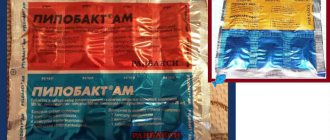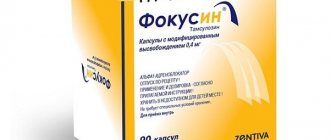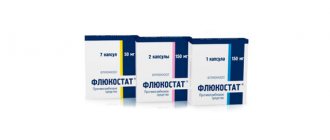Release form and composition
Dosage form - capsules: hard gelatin, with an orange-pink cap with a black inscription "IXEL" and a body: size No. 4 - orange-pink color with a black imprint "25", size No. 3 - yellow-orange color with a black imprint " 50"; the contents of the capsules are almost white to white powder, the presence of lumps is allowed, which turn into powder with light pressure (14 pieces in blisters, 2 or 4 blisters in a cardboard pack).
The active ingredient in Ixel is milnacipran hydrochloride, 25 or 50 mg in 1 capsule.
Auxiliary components: carmellose calcium, calcium hydrogen phosphate dihydrate, povidone K30, magnesium stearate, colloidal silicon dioxide, talc.
Composition of the capsule shell: gelatin, red iron oxide (E172), titanium dioxide (E171), yellow iron oxide (E172).
Ixel
Active substance:
Milnacipran*
Pharmgroup:
Antidepressants
Average price in pharmacies
| Name | Manufacturer | average price |
| Ixel 0.025 n56 caps | Pierre Fabre Medicine Production | 1681.00 |
| Xcel 0.05 n56 caps | Pierre Fabre Medicine Production | 2473.00 |
Analogs for the active substance:No data on synonyms | Application area:Bipolar disorder Bipolar disorders Bipolar disorders Bipolar psychosis Secondary depression Double depression Depressive pseudodementia Depressive mood disorder Depressive disorder Depressive mood disorder Depressive state Depressive syndrome Depressive episode of bipolar disorder Masked depressions Depression Depression smiling Involutional depression Involutional depressions Intermittent psychosis Affective insanity Manic-depressive syndrome Manic-melancholic psychosis Masked depression Melancholic attack Manic-depressive psychosis Mood disorders bipolar Reactive depression Reactive depression with moderate psychopathological symptoms Reactive depressive states Cyclophrenia Circular psychosis Exogenous depression Endogenous depression Endogenous depressive states Endogenous depression Endogenous depressive syndrome |
Pharmacological properties
Pharmacodynamics
Milnacipran is a selective monoamine reuptake inhibitor [norepinephrine and serotonin (5 HT)]. The substance does not bind to H1-histamine receptors, α1-adrenergic receptors, m-cholinergic receptors, as well as D1 and D2-dopaminergic, opioid and benzodiazepine receptors.
Milnacipran has virtually no effect on cardiac conduction or repolarization. It also does not change cognitive function and is characterized by a weak sedative effect.
Milnacipran demonstrates high effectiveness in the treatment of patients with sleep disorders caused by depression. In this case, the total duration of sleep increases, the time to fall asleep is minimized, the time interval before the onset of the rapid phase of sleep increases, and the number of night awakenings decreases.
The effectiveness of the drug is comparable to the effectiveness of tricyclic antidepressants and selective serotonin reuptake inhibitors, but is less than that of clomipramine.
Pharmacokinetics
When taken orally, milnacipran is well absorbed. Its bioavailability reaches 85% and is not determined by the characteristics and diet. The maximum concentration of the substance in the blood plasma is recorded approximately 2 hours after oral administration. When taking Ixel in a single dose of 50 mg, the maximum blood level of milnacipran is approximately 120 ng/ml. When taking the drug in doses not exceeding 200 mg, a dose-dependent increase in maximum concentration is observed. After repeated doses of Ixel, the equilibrium concentration is achieved within 2-3 days, and it is 70–100% higher than when taking a single dose (maximum concentration about 216 ng/ml). Interindividual variability remains low.
Milnacipran binds to plasma proteins slightly (approximately 13%), and binding is characterized by unsaturation. The volume of distribution is approximately 5 l/kg with a total clearance of approximately 40 l/hour. Nonrenal and renal clearance are the same.
Milnacipran practically does not participate in metabolic processes. No active metabolite was found; the substance is conjugated with glucuronic acid. The half-life of the active component of Ixel is approximately 8 hours. Milnacipran is excreted unchanged mainly in the urine (approximately 90% of the administered dose) due to tubular secretion.
After completing the course of treatment, milnacipran is completely eliminated from the body within 2-3 days after discontinuation of the drug.
Liver dysfunction does not cause significant changes in the pharmacokinetic parameters of milnacipran. The rate of elimination of the substance decreases in proportion to the degree of kidney damage in patients with renal failure.
In elderly patients, the pharmacokinetic parameters of milnacipran do not change significantly. However, when selecting a dose, it is necessary to take into account physiological changes in renal function in elderly patients.
Based on information obtained from preclinical studies, the target organ of multiple doses of Ixel is the liver. Adverse reactions were observed when taking high doses, approximately 10 times higher than recommended, and were reversible. Preclinical information obtained from reproductive toxicity, genotoxicity, and habitual toxicity studies of milnacipran does not support potential risks to patient health. The substance has neither carcinogenic nor mutagenic properties.
Ixel
Adverse reactions are systematized by system-organ classes and listed according to the following gradation:
very common (≥1/10), common (≥1/100 to <1/10), uncommon (≥1/1000 to <1/100), rare (≥1/10000 to <1/1000) , very rare (< 1/10000), frequency unknown (single reports, frequency cannot be estimated from available data).
Blood and lymphatic system disorders
Frequency unknown: hemorrhages in the skin and mucous membranes (ecchymosis).
Immune system disorders
Uncommon: hypersensitivity.
Rarely: anaphylactic shock.
Endocrine system disorders
Rare: syndrome of inappropriate secretion of antidiuretic hormone.
Metabolic and nutritional disorders
Uncommon: hyperlipidemia, weight loss.
Frequency unknown: hyponatremia.
Mental disorders
Common: agitation, anxiety, depression, eating disorders, sleep disturbances, suicidal behavior (suicide attempts and suicidal thoughts).
Uncommon: panic attack, confusion, delirium, hallucinations, mania, decreased libido, nightmares, suicidal ideation.
Rarely: derealization, pathological thinking, mental disorder.
Frequency unknown: aggression.
Nervous system disorders
Very common: headache.
Common: migraine, tremor, feeling of dizziness, dysesthesia (sensitivity disorder), drowsiness.
Uncommon: memory impairment, akathisia, balance disorder, taste disturbance, fainting.
Rarely: acute cerebrovascular accident, dyskinesia, shaking paralysis (parkinsonism), seizures.
Frequency unknown: serotonin syndrome (for a description, see the section “Interaction with other drugs”), seizures.
Visual disorders
Uncommon: feeling of dry eyes, eye pain, mydriasis, impaired accommodation, blurred vision, blurred vision.
Hearing and labyrinth disorders
Uncommon: tinnitus, vertigo.
Heart disorders
Often: tachycardia, palpitations.
Uncommon: cardiac arrhythmia, bundle branch block, extrasystole, myocardial infarction.
Rarely: angina pectoris.
Vascular disorders
Often: a feeling of a rush of blood to the head, increased blood pressure.
Uncommon: Raynaud's disease, decreased blood pressure, orthostatic hypotension.
Respiratory, thoracic and mediastinal disorders
Uncommon: cough, dyspnea, dry nasal mucosa, pharyngeal disorders.
Gastrointestinal disorders
Very common: nausea.
Common: constipation, diarrhea, abdominal pain, indigestion, vomiting, dry mouth.
Uncommon: colitis, gastritis, impaired gastrointestinal motility, discomfort in the gastrointestinal tract, bloating, gastric and duodenal ulcers, hemorrhoids, stomatitis.
Disorders of the liver and biliary tract
Uncommon: increased concentrations of liver enzymes in blood plasma.
Rarely: hepatitis, hepatocellular disorders.
Frequency unknown: cytolytic hepatitis.
Skin and subcutaneous tissue disorders
Common: itching, rash, increased sweating
Uncommon: allergic reaction (urticaria), dermatitis, dermatosis.
Rarely: sensitization reactions
Frequency unknown: Stevens-Johnson syndrome
Musculoskeletal and connective tissue disorders
Common: musculoskeletal pain
Uncommon: muscle rigidity, myalgia.
Renal and urinary tract disorders
Common: difficulty urinating, frequent urination.
Uncommon: chromaturia, urinary incontinence, urinary retention.
Genital and breast disorders
Common: ejaculation disorders, erectile dysfunction, testicular pain.
Uncommon: amenorrhea, hypermenorrhea, menstrual irregularities, uterine bleeding, prostate dysfunction.
General and administration site disorders
Often: feeling tired.
Uncommon: fever, chest pain, chills, feeling unwell, general malaise.
Contraindications
- Concomitant use with sumatriptan, non-selective and selective monoamine oxidase (MAO) type B inhibitors, selective MAO type A inhibitors, digoxin;
- Age up to 15 years;
- Obstruction of the urinary tract (including due to prostatic hyperplasia);
- Pregnancy and breastfeeding period;
- Concomitant therapy with norepinephrine, adrenaline, clonidine or its derivatives;
- Hypersensitivity to the components of the drug.
Particular caution should be exercised when prescribing Ixel to patients with angle-closure glaucoma, a history of seizures, epilepsy, benign prostatic hyperplasia (adenoma), renal failure, arterial hypertension, and cardiomyopathy.
Instructions for use of Ixel: method and dosage
Capsules should be taken orally in the first half of the day, preferably with meals.
The dose and duration of therapy are prescribed by the doctor based on the individual severity of symptoms.
The recommended average daily dose of Ixel is 100 mg, divided into 2 doses.
To achieve a sustainable therapeutic effect in severe forms of the disease, an increase in dose is indicated, but not higher than 250 mg per day.
For patients with renal failure with a creatinine clearance (CC) of 50-10 ml/min, it is recommended to reduce the daily dose taking into account the creatinine clearance values.
Overdose
In case of an overdose of Ixel, the first symptoms of this condition are constipation, excessive sweating, nausea, and vomiting. Taking the drug in a dose of more than 800–1000 mg causes tachycardia, breathing problems, and vomiting. When taking Ixel in an extremely high dose (1900–2800 mg) in combination with other psychotropic drugs (mainly benzodiazepines), disturbances of consciousness, hypercapnia, and severe drowsiness are added to the symptoms listed above. An overdose of milnacipran does not lead to the development of cardiotoxicity.
In this situation, you should immediately rinse your stomach, take activated charcoal and consult a doctor who will prescribe symptomatic therapy. There is no specific antidote to milnacipran. It is recommended to monitor the patient's condition for at least one day.
special instructions
Due to a slight increase in heart rate while taking Ixel, patients with cardiomyopathy and arterial hypertension should use the drug with caution.
Side effects are rare and do not require discontinuation of Ixel. Adverse reactions, as a rule, appear during the first 2 weeks of treatment, are of minor severity and disappear on their own as the symptoms of depression decrease. To reduce the severity and number of side effects, it is recommended to increase the dose gradually during therapy.
The antidepressant Ixel can be prescribed after stopping MAO inhibitors no earlier than 2 weeks, and taking MAO inhibitors should start a week after stopping the drug.
Alcohol consumption is contraindicated during treatment.
Patients should refrain from driving vehicles and machinery during the entire period of therapy.
Ixel, 56 pcs., 25 mg, capsules
When drugs that affect the reuptake of serotonin are combined with drugs that suppress its metabolism (including MAO inhibitors and antipsychotics), the development of serotonin syndrome is possible. Serotonin syndrome or malignant neuroleptic syndrome (manifested by increased nervous excitability, the development of hallucinations, coma, tachycardia, blood pressure lability, hyperthermia, hyperreflexia, impaired coordination of movements, nausea, vomiting, diarrhea) poses a potential danger to the patient’s life.
Ixel can be prescribed no earlier than 2 weeks after discontinuation of MAO inhibitors. The time interval from the moment you stop taking Ixel before starting therapy with MAO inhibitors should be at least 1 week.
Ixel should be used with extreme caution in patients with prostatic hyperplasia, a history of epileptic seizures, as well as in patients with arterial hypertension or hypertrophic cardiomyopathy (especially obstructive).
In children, adolescents and people under 24 years of age, when prescribing antidepressants, the risk of suicidal thoughts and suicidal behavior increases, and therefore, when prescribing milnacipran to this category of people, the risk of suicide should be weighed against the benefits of their use.
In short-term studies, the risk of suicide did not increase in patients over 24 years of age, and even decreased slightly in those over 65 years of age. During treatment with antidepressants, all patients should be monitored for early detection of disturbances or changes in behavior, as well as suicidality.
Drugs that inhibit the reuptake of norepinephrine and serotonin (including milnacipran) can cause increased blood pressure and increased heart rate. However, it should be noted that the severity of these phenomena when taking recommended doses is usually insignificant, is not felt by patients and usually does not require drug correction. Studies on the effect of milnacipran on blood pressure in patients with concomitant uncontrolled arterial hypertension, as well as on heart rate in patients with rhythm disturbances, have not yet been conducted. However, before starting treatment, during dose selection and during treatment, monitoring of blood pressure and heart rate levels is required. For persons suffering from arterial hypertension or other cardiovascular diseases, it is advisable to select effective therapy before prescribing milnacipran.
Cases of increased liver transaminase activity (up to 3 times higher than ULN) in patients taking milnacipran have been described. There was no clinically significant increase in bilirubin. There are isolated reports in the literature about the development of toxic hepatitis in patients while taking milnacipran, however, according to these reports, a clear cause-and-effect relationship cannot currently be traced (there were simultaneous use of other drugs and previous concomitant diseases of the hepatobiliary organs.
If signs of liver damage appear while taking milnacipran, its use should be discontinued. It is undesirable to prescribe milnacipran to persons who abuse alcohol and/or have concomitant liver diseases.
During treatment, it is not recommended to drink alcohol (milnacipran can potentially enhance the negative effects of ethanol on the liver).
With abrupt withdrawal of milnacipran, the following are possible: mood swings, agitation, weakness, paresthesia, anxiety, headache, drowsiness, emotional lability, convulsive syndrome. The severity of these phenomena is usually insignificant, but if they develop, the rate of drug withdrawal should be reduced.
Prescribing milnacipran to patients with a history of mania and/or hypomania should be done with caution due to the potential for exacerbation of these conditions.
Based on the mechanism of action, milnacipran can potentially cause (intensify) disturbances in the outflow of urine (primarily in patients with concomitant prostatic hypertrophy and prostatitis), which certainly requires appropriate monitoring.
Milnacipran, causing pupil dilation, can contribute to an increase in IOP (should be taken into account in patients with initially high ophthalmotonus against a background of poorly controlled angle-closure glaucoma).
Drug interactions
Since the simultaneous use of Ixel with sumatriptan, non-selective MAO inhibitors (iproniazide), selective MAO type B inhibitors (selegiline) may develop serotonin syndrome, coronary artery spasm, arterial hypertension, it is necessary to strictly observe a break of 2 weeks between the administration of these drugs.
When combined with norepinephrine and adrenaline, arterial hypertension and arrhythmia may occur; if local anesthesia is necessary while taking an antidepressant, their doses should not exceed 0.1 mg in 10 minutes or 0.3 mg in 60 minutes.
It is not recommended to prescribe Ixel simultaneously with digoxin (especially when administered by injection), as this can cause the development of arterial hypertension and tachycardia; clonidine and similar compounds - due to a decrease in their hypotensive effect.
Concomitant therapy with toloxatone, moclobemide and other selective MAO type A inhibitors, lithium preparations poses a threat of serotonin syndrome.
Instructions:
Clinical and pharmacological group
02.002 (Antidepressant)
Release form, composition and packaging
Gelatin capsules (hard), size No. 4, with an orange-pink cap with a black imprint “IXEL” and an orange-pink body with a black imprint “25”; the contents of the capsules are a white to almost white powder; the presence of conglomerates (lumps) is allowed, which, when pressed with a glass rod, easily turns into powder.
| 1 caps. | |
| milnacipran hydrochloride | 25 mg |
Excipients: calcium hydrogen phosphate dihydrate, calcium carmellose, povidone K30 (polyvidone K30), colloidal anhydrous silicon dioxide, magnesium stearate, talc.
Composition of the capsule shell: titanium dioxide (E171), red iron oxide (E172), yellow iron oxide (E172), gelatin.
14 pcs. - blisters (2) - cardboard packs. 14 pcs. - blisters (4) - cardboard packs.
Gelatin capsules (hard), size No. 3, with an orange-pink cap with a black imprint “IXEL” and a yellow-orange body (rust color) with a black imprint “50”; the contents of the capsules are a white to almost white powder; the presence of conglomerates (lumps) is allowed, which, when pressed with a glass rod, easily turns into powder.
| 1 caps. | |
| milnacipran hydrochloride | 50 mg |
Excipients: calcium hydrogen phosphate dihydrate, calcium carmellose, povidone K30 (polyvidone K30), colloidal anhydrous silicon dioxide, magnesium stearate, talc.
Composition of the capsule shell: titanium dioxide (E171), red iron oxide (E172), yellow iron oxide (E172), gelatin.
14 pcs. - blisters (2) - cardboard packs. 14 pcs. - blisters (4) - cardboard packs.
pharmachologic effect
Antidepressant, selective monoamine reuptake inhibitor (norepinephrine and serotonin). Ixel does not bind to m-cholinergic receptors, α1-adrenergic receptors, histamine H1 receptors, as well as dopamine D1 and D2 receptors, benzodiazepine and opioid receptors.
It does not have a sedative effect, but physiologically improves sleep and does not have a negative effect on cognitive function. Ixel also does not affect the conduction system of the heart and blood pressure, which is especially important for elderly patients who are constantly taking cardiotropic drugs.
Pharmacokinetics
Suction
After taking the drug orally, milnacipran is well absorbed from the gastrointestinal tract. Bioavailability is about 85% and does not depend on the nature and diet. Cmax in blood plasma is achieved approximately 2 hours after administration.
Distribution
An equilibrium state is achieved after 2-3 days of regular use. Plasma protein binding is about 13% and is not saturated.
Metabolism
Biotransformed mainly by conjugation with glucuronic acid. Metabolites do not have pharmacological activity.
Removal
T1/2 is 8 hours. It is excreted mainly by the kidneys - about 90%. It is completely eliminated from the body within 2-3 days.
Dosage
Ixel is intended for oral administration.
The average daily dose is 100 mg; The drug should be taken in 2 doses in the morning. Depending on the severity of symptoms, the dose can be increased to 250 mg/day.
It is preferable to take the drug with food.
The duration of therapy is determined individually.
In patients with renal failure (creatinine clearance 50-10 ml/min), a reduction in the daily dose is recommended depending on the clearance values.
Overdose
Symptoms: with an accidental increase in dose, nausea, vomiting, sweating, and constipation were noted. When taking the drug in a dose exceeding 800-1000 mg, vomiting, difficulty breathing, and tachycardia are possible. After taking an excessively high dose (1900-2800 mg of milnacipran) in combination with other psychotropic drugs (most often benzodiazepines), drowsiness, hypercapnia, and disturbances of consciousness are added to the symptoms described above. No manifestations of cardiotoxicity or death were observed with an overdose of Ixel.
Treatment: gastric lavage followed by symptomatic therapy. Medical observation of the patient's condition for at least 24 hours is recommended. A specific antidote is unknown.
Drug interactions
The simultaneous use of Ixel with non-selective MAO inhibitors (iproniazide), with selective MAO type B inhibitors (selegiline), with sumatriptan due to the risk of developing serotonin syndrome, arterial hypertension, coronary artery spasm (the minimum interval after the end of treatment with these drugs and the appointment of Ixel is 2 weeks ).
The simultaneous use of Ixel with adrenaline and norepinephrine is not recommended due to the risk of arterial hypertension and arrhythmia; with clonidine and related compounds due to a decrease in their hypotensive effect; with digoxin (especially when administered parenterally) due to the risk of developing tachycardia and arterial hypertension; with selective MAO type A inhibitors (moclobemide, toloxatone) due to the risk of developing serotonin syndrome.
Ixel should be prescribed with caution in combination with epinephrine (adrenaline) and norepinephrine (norepinephrine) (in the case of local anesthesia, doses should not exceed 100 mcg per 10 minutes or 300 mcg per 1 hour), with lithium preparations due to the risk of developing serotonin syndrome .
Use during pregnancy and lactation
It is not recommended to prescribe Ixel during pregnancy and lactation.
Side effects
From the side of the central nervous system: possible - anxiety, dizziness; rarely - tremor, headache.
From the digestive system: rarely - dry mouth, nausea, vomiting, constipation; in some cases - a moderate increase in transaminase activity without clinical manifestations.
Other: possible - increased sweating, hot flashes, difficulty urinating; rarely - palpitations, rash; in some cases - serotonin syndrome.
Side effects are observed rarely, mainly during the first 2 weeks of therapy, are mild, usually self-limited as symptoms of depression regress and do not require discontinuation of the drug. The severity and number of side effects can be reduced by gradually increasing the dose of the drug during treatment.
Storage conditions and periods
The drug should be stored out of the reach of children at a temperature not exceeding 30°C. Shelf life: 3 years.
Indications
- depressive disorders of varying severity.
Contraindications
Absolute
- children and adolescents under 15 years of age (due to lack of clinical data);
- simultaneous use of non-selective and selective MAO type B inhibitors, sumatriptan;
- hypersensitivity to the components of the drug.
Relative
- obstruction of the urinary tract (mainly due to prostatic hyperplasia);
- pregnancy;
- lactation (breastfeeding);
- simultaneous use with adrenaline, norepinephrine, clonidine and its derivatives;
- simultaneous use of selective MAO type A inhibitors, digoxin.
The drug should be used with caution in case of angle-closure glaucoma and epilepsy.
special instructions
The drug should be used with extreme caution in patients with adenoma (benign hyperplasia) of the prostate gland, with a history of seizures, arterial hypertension, cardiomyopathy (due to a slight increase in heart rate).
Ixel can be prescribed no earlier than 14 days after discontinuation of MAO inhibitors. In addition, at least 7 days must pass from the moment of discontinuation of the drug Ixel to the start of therapy with MAO inhibitors.
Avoid drinking alcohol during treatment with Ixel.
Impact on the ability to drive vehicles and operate machinery
During the period of use of the drug, you should refrain from engaging in potentially hazardous activities that require increased attention and rapid psychomotor reactions.
Use for renal impairment
In patients with renal failure (creatinine clearance 50-10 ml/min), a reduction in the daily dose is recommended depending on the clearance values.
Use the drug with caution in cases of urinary tract obstruction (especially in cases of benign prostatic hyperplasia).
Use for liver dysfunction
In some cases, a moderate increase in transaminase activity without clinical manifestations is observed.
Conditions for dispensing from pharmacies
The drug is available with a prescription.
Reviews about Ixelles
Many patients leave positive reviews about Ixel. They claim that it helps well with prolonged depression and panic attacks: interest in life appears, anxiety and feelings of weakness disappear, and there are almost no side effects. It can be taken for a long period of time (6 months or more), gradually reducing the dose.
However, some patients do not like the high cost of the drug and the need to purchase it on order. Also, in isolated cases, insufficient effectiveness of the drug and manifestations of allergic reactions are noted.








